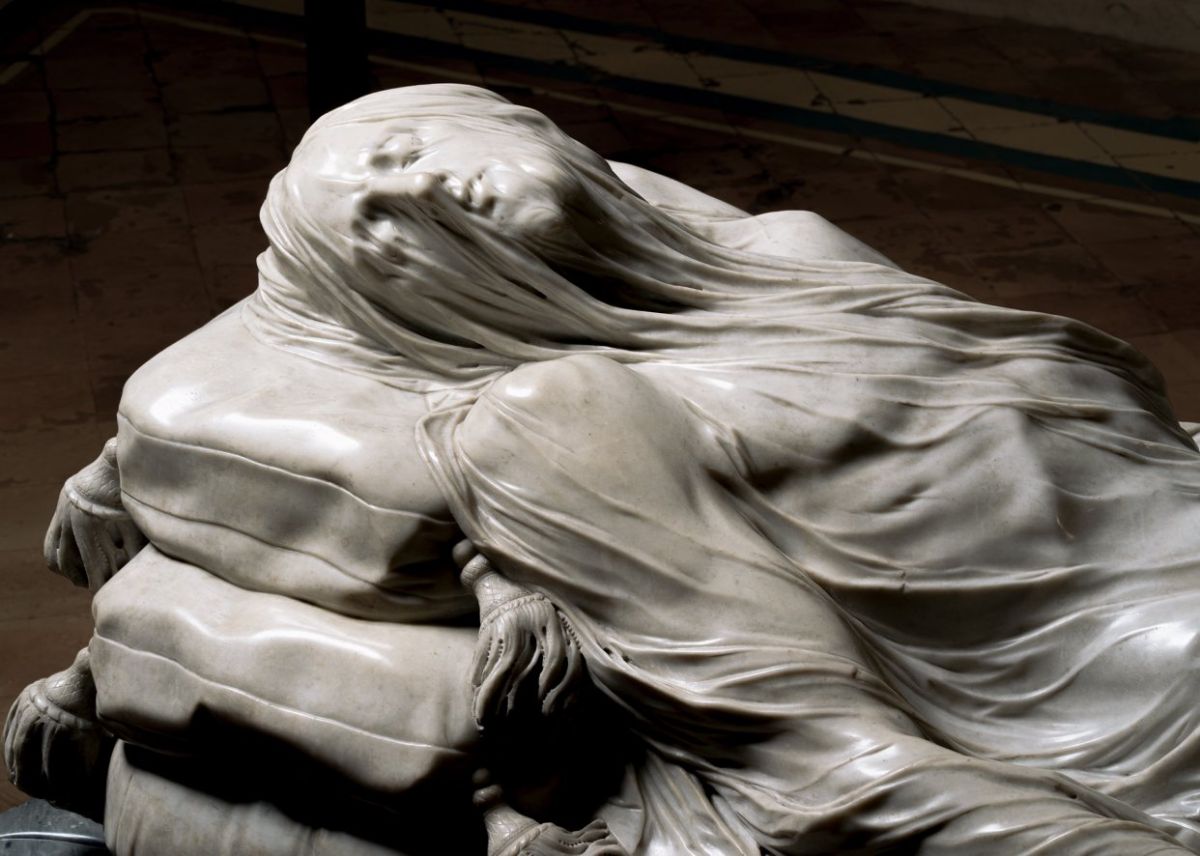15-DAY ITALIAN EXCELLENCES
PRIVATE TOUR
The ultimate tour at the discovery of the Excellences of the Country. From the wines of Veneto and Tuscany to the prosciutto of Emilia and olive oil of Umbria, from the cheese of Val d’Orcia to the buffalo mozzarella of Paestum and the bread of Matera, from alabaster in Volterra to Ceramics in Deruta. A once-in-a-lifetime experience which you’ll never forget!
HIGHLIGHTS
- Verona, the city of lovers
- Parma, the art of food
- Volterra, masters of the “smooth” stones
- Chianti, winemakers for 1,000 years
- Val d’Orcia, where man and nature blend with harmony
- Assisi, the extraordinary land of Francis
- Umbria, the green heart of Italy
- Castelli Romani, where Romans enjoy life
- The coast of Amalfi, where divas are at home
- Paestum, when Greeks ruled Italy
- Matera, the city of stone
- Naples, Pizza time
WHAT’S INCLUDED
Overnights at 3* to 5* Hotels, Country Houses and Historical Palaces (when available), City Apartments along the itinerary
Transfers by private car / minivan / minibus
Activities:
- Day 1: Visit of a Valpolicella wine cellar with tastings – 2-hour private walking tour of Verona city centre with an Authorised Tourist Guide
- Day 2: Visit of a Balsamic Vinegar of Modena Producer with tasting – Admission to Museo Ferrari in Maranello
- Day 3: Full-day excursion of Parma area with an Authorised Tourist Guide – Visits to a Parmesan Cheese factory, a Parma Ham factory and A Lambrusco wine cellar with tastings
- Day 4: Visit of an Alabaster Laboratory in Volterra
- Day 5: Full-day private E-bike excursion of Chianti area – Visit of a Chianti wine cellar with tasting
- Day 6: Admission to San Galgano Abbey in Chiusdino – Visit of a Brunello di Montalcino wine cellar with tastings
- Day 7: Full-day excursion to Val d’Orcia area: Bagno Vignoni and Montepulciano – 3-hour private gourmet walking tour of Montepulciano city centre with an Authorised Tourist Guide, with tastings of Vino Nobile, Pecorino cheese and truffle
- Day 8: Visit of a Sagrantino di Montefalco winery with tasting – Umbrian Cooking Class with dinner
- Day 9: Full-day excursion to Assisi area – Truffle hunt experience with lunch in Assisi area
- Day 10: Visit of an Umbrian olive oil mill with tastings
- Day 11: Visit of a Frascati wine cellar with tastings
- Day 12: Lemoncello Experience with lunch in Amalfi
- Day 13: 2-hour private walking tour of Paestum Archeological Area with an Authorised Tourist Guide – Admission to Paestum Archeological Area – Lunch at a Buffalo Mozzarella Farm with tastings
- Day 14: 3-hour private walking tour of Matera city centre with an Authorised Tourist Guide – Materan Cooking Class
- Day 15:Food tour in Naples with an Authorised Tourist Guide
Customizations and Options:
- Pick up at Milan Airport / Railway Station at the start of the tour
- Accommodation in Milan the night before the start of the tour
- Drop off at Naples Airport / Railway Station at the end of the tour
- Other options upon request
Benvenuti in Italia, welcome to Verona!
In a stretch of land designed in accord with the bends and twists of the River Adige, we find Verona, a visually stunning city of excellence. It is a city of many faces whose history can also summarize Italy’s history – think of the works left by the Romans, the Medieval streets and the “palazzi” of the Renaissance.
The city’s commercial hub is Piazza delle Erbe, where the original Roman Forum was. This piazza represents the synthesis of several different historical moments: the 13th-century buildings – among which Casa dei Mercanti (House of Merchants) stands out – the painted facades of the Mazzanti Houses and the Madonna Verona Fountain, with its central statue from the Roman Epoch. Also, dating back to Roman times, the most symbolic monument of Verona is the Arena (1st century B.C.). Originally constructed to host gladiator combats, it saw a long period of abandonment before it returned to the limelight with a new form of entertainment in 1913: after having hosted the premiere of Aida in that year, it has been known around the world for the sounds of opera that emanate from its stage.
Then, Romanesque Verona lies in its imposing Duomo, as well as in the Cathedral of St. Zeno, and in Castelvecchio, which looks out from the banks of the Adige; it symbolizes the Medieval power of the Scaliger family, to whom the realization of the crenellated Scaliger Bridge is attributed.
Verona’s palazzi narrates its long history of wealth and power. In Piazza dei Signori – which sits under the dominating Lamberti Towers – the portico of the Loggia del Consiglio catches the eye; in the 16th century, political life took place here, while the Palazzo di Cansignorio and Palazzo del Comune (or “della Ragione”) were the seats of military, judicial and administrative power. Nearby lie the Scaliger Arches, in the same-named piazza, and some of the most suggestive views of the city, including glimpses of the monumental tombs of the Lords of Verona.
Finally, the Verona of Shakespeare and the “star-crossed lovers” is a worldwide legend and lives indefinitely through the places made famous in Romeo and Juliet. Yet the original literary work was created by Luigi da Porto, a writer from Vicenza, in the 1500s; it eventually circulated in Europe, reaching England. It was the Bard who rendered it the immortal story it is today, allowing Verona to rest as one of the most admired and visited places in the world.
And remember: Verona is a very elegant city, famous for its classy shops!
A few kilometres west of Verona, in a landscape of valleys and hills descending from the mountains to the plains around the Adige, Valpolicella hosts the vineyards supplying the grapes for two of the most excellent Italian red wines: Recioto and Amarone. The starting point for both wines is the same: ripe and high-quality grapes, harvested and stored in the “fruttai”, well-ventilated and dry places, where they are left to dry for 100 – 120 days. Grapes with their thick skin lose water and sugar concentrate. After crushing, fermentation takes place, which is shorter for the Recioto to leave a high percentage of sugars and longer for the Amarone. Two wines for connoisseurs, which you can enjoy at one of the most beautiful wineries in the area.
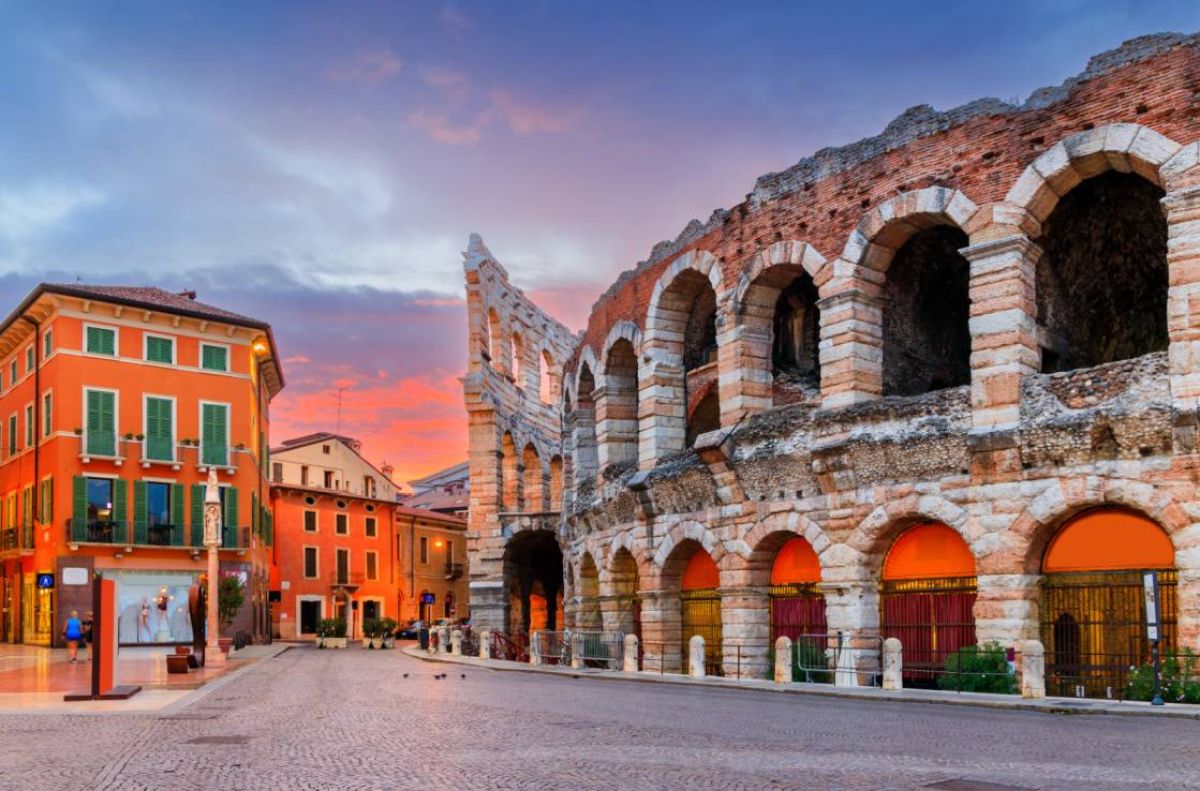
Modena is renowned worldwide for the famous people – Enzo Ferrari and Luciano Pavarotti above all – who were born and lived here, and for some of its gastronomical products. The city is the capital of the so-called “Motor Valley”: actually, the factories of the famous Italian sports car makers Ferrari, De Tomaso, Lamborghini and Maserati are located here.
The city of Modena hosts little jewels of art, such as the Romanesque Cathedral, which was built with white marble and is located in the heart of Modena, in Piazza Grande. The Piazza with the Cathedral and the Ghirlandina Tower is one of the 48 Italian sites on the UNESCO World Heritage List. The Ghirlandina, the bell tower rising majestically over the rooftops, derives from its marble balustrades around the steeple, suggesting the lightness of garlands.
Afterwards, you will move to the estate of a Balsamic Vinegar of Modena Producer to delight in the unique, enticing taste of traditional balsamic vinegar. Balsamic Vinegar of Modena is obtained from partially fermented, cooked and concentrated grape must. The grapes come exclusively from the area’s vines, and the most critical processing phase is refinement inside containers of fine wood, such as oak, chestnut, oak, mulberry and juniper. Want to know more about this unique delicacy? Read the article in our BLOG.
In Maranello, you will visit Museo Ferrari, not just a collection of the past but an extraordinary experience of the world of Ferrari and sports car racing! How exciting to see the most beautiful cars in the world, exceptional artworks made by modern mechanic artisan masters.
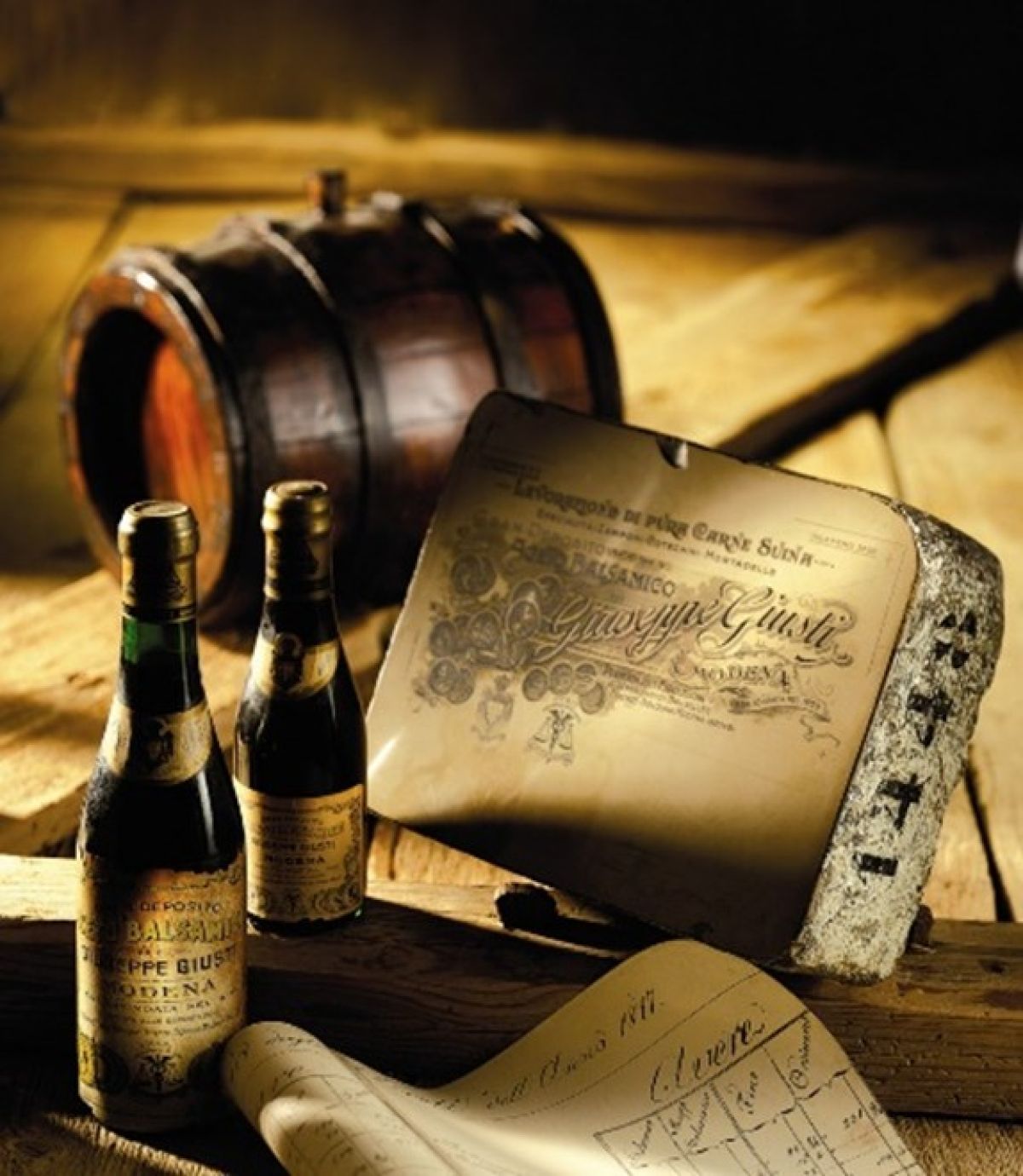
Your next destination is called “The Capital of Food”, and this is a well-deserved denomination, as Parma is known worldwide for its delicious food products.
Parma is known for its delicious food products. First, you will visit a Parmigiano Reggiano factory, where you will see cheese masters at work: an extraordinary way to get into the area’s production culture and discover how a true gastronomic gem is made (more about Parmesan cheese in our BLOG).
Later on, visit a Parma ham factory, where you will learn the secrets of the most delicious ham, Prosciutto di Parma (to know more about raw ham in Italy, read the article in our BLOG).
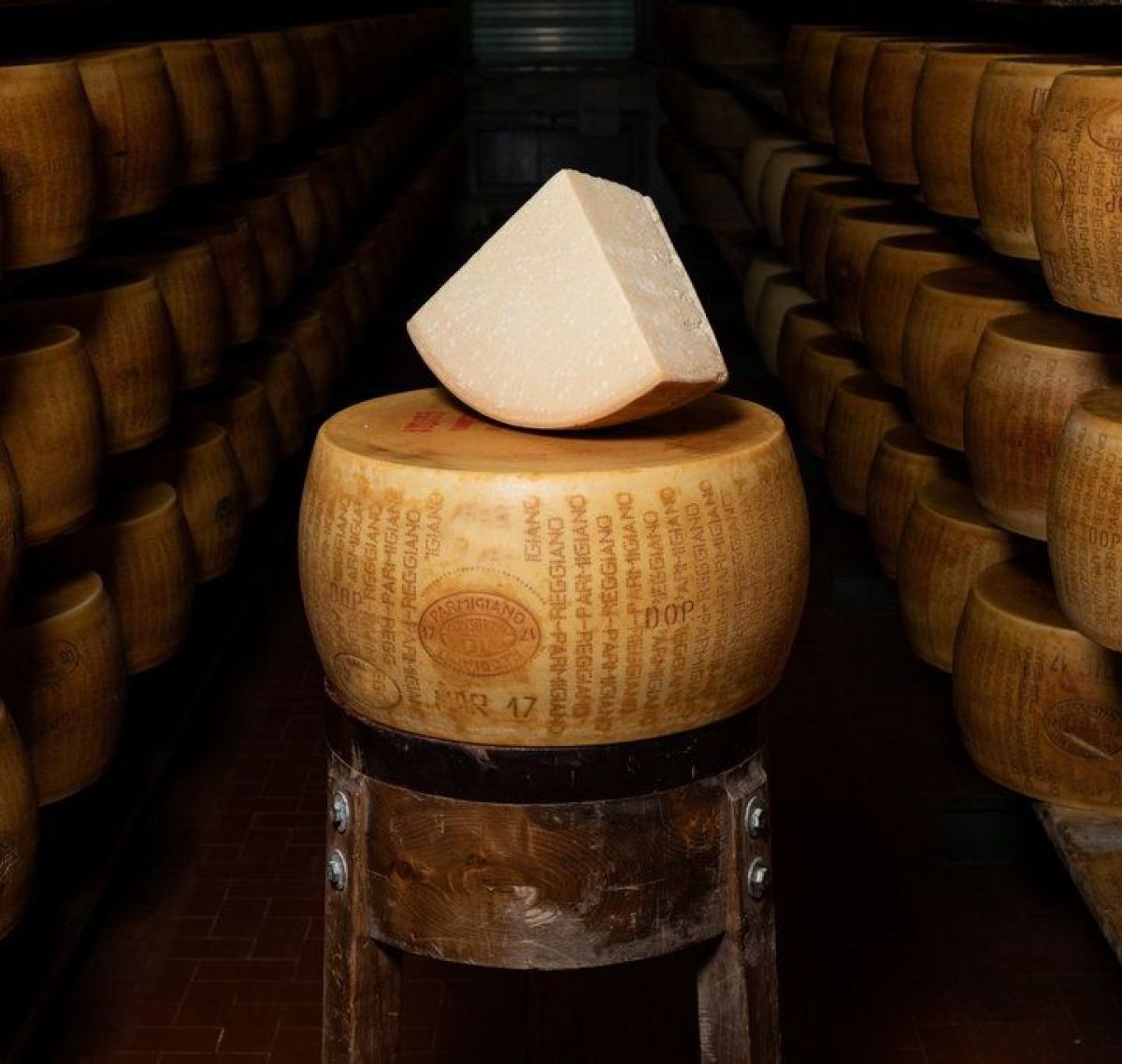
Not far from San Gimignano is Volterra, Tuscany’s oldest continuously inhabited town, with settlements documented since 1,500 B.C. It’s, therefore, an excellent way to know not only about Volterra’s history but also about Tuscany as a whole.
You will visit Piazza dei Priori, the main square, the centre of civic power since the 8th century, and Porta all’Arco, the 4th century B.C. Etruscan gate to the city walls, its 12th-century Cathedral and the ruins of the Roman Theater (40 B.C.) and Roman Baths (3rd century AD). Volterra is famous for its alabaster; here, you will find beautiful shops selling artefacts and unique handmade pieces carved into this semi-transparent stone.
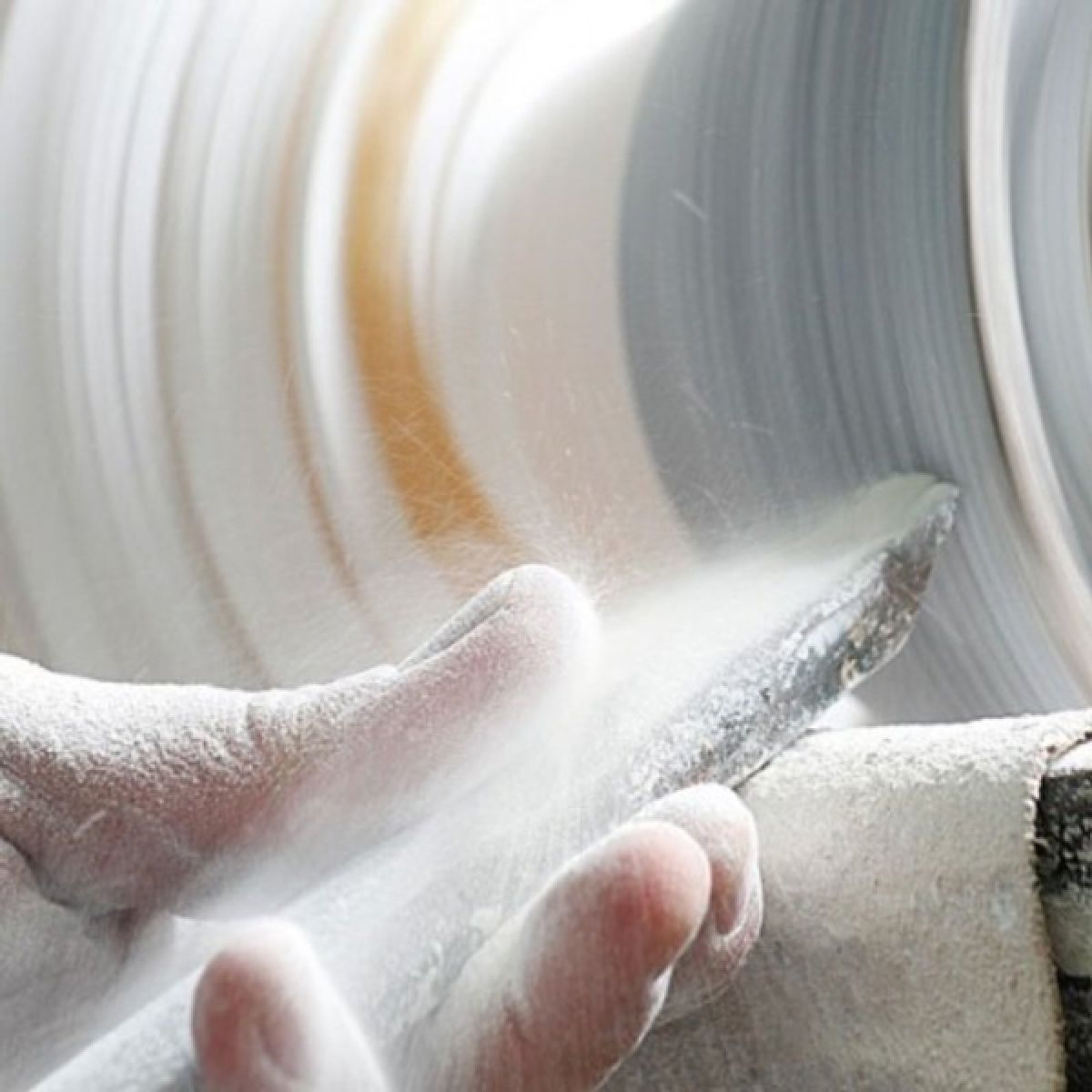
Only a few regions can offer such a beautiful and rich panorama as Chianti: green hills sketched by miles and miles of vineyards and olive groves, ancient walled villages, and panoramic curvy roads. Chianti Classico spreads from Florence to Siena and includes the municipalities of Greve, Panzano, Radda, Gaiole and Castellina. Most of the route consists of roads connecting larger towns to villages and castles, like the one leading to Radda, the former headquarters of the Chianti Military League, and then to Castello di Brolio, where Bettino Ricasoli devised the “recipe” for Chianti wine.
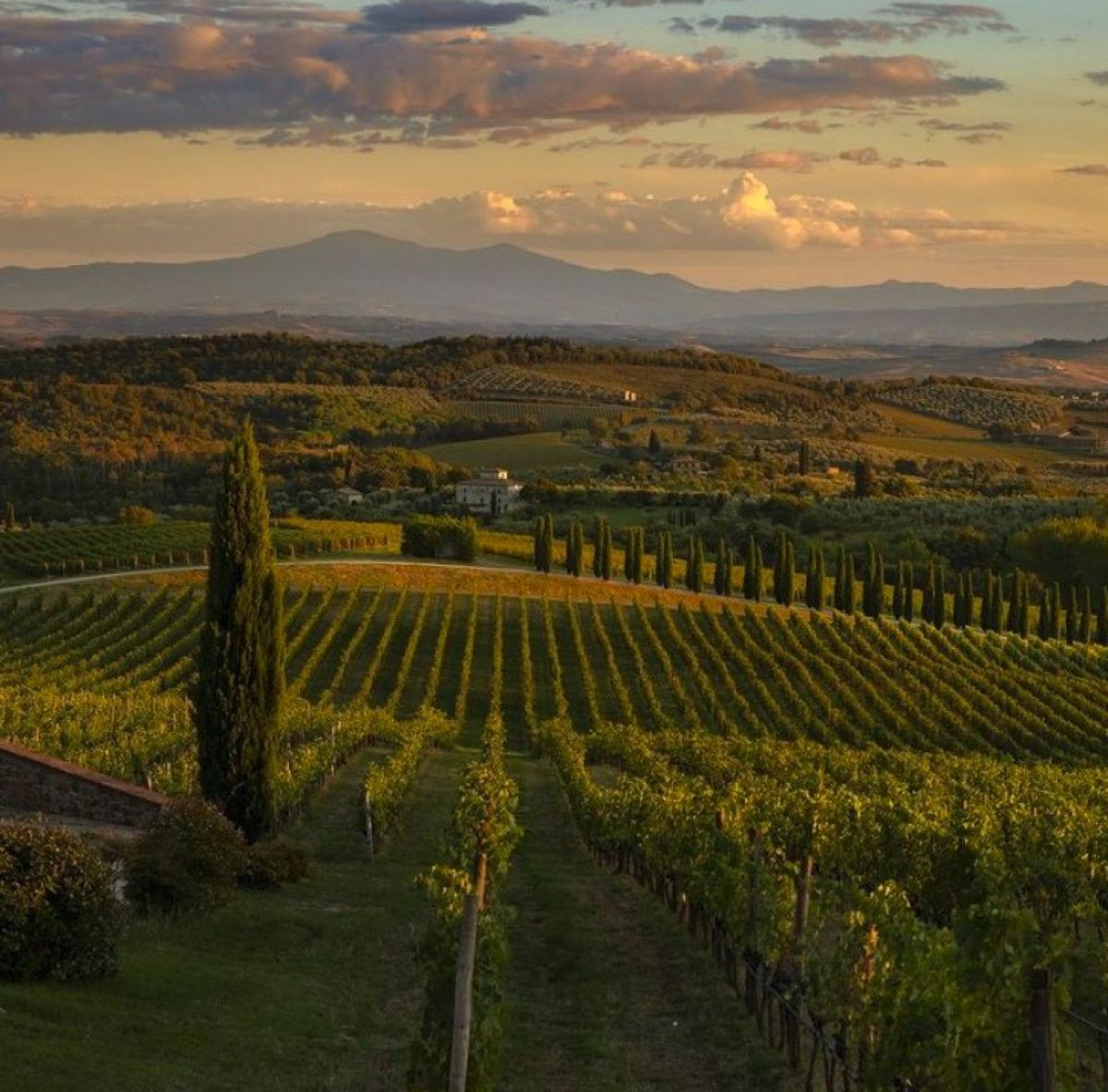
Val d’Orcia is one of the most fascinating places in Italy, included by UNESCO in the list of World Heritage Sites. Its landscape is a part of the agricultural hinterland of Siena, redrawn and developed when it was integrated into the city-state’s territory in the 14th and 15th centuries to reflect an idealized model of good governance and create an aesthetically pleasing picture. The landscape’s distinctive aesthetics, flat chalk plains with almost conical hills and fortified settlements on top, inspired many artists. Their images have come to exemplify the beauty of well-managed Renaissance agricultural landscapes.
In Montepulciano, our friend Francesca will lead you to discover this beautiful town full of stories, legends and thousand flavours, introducing you to the excellent products of this unique land: olive oil, pecorino cheese and Vino Nobile di Montepulciano.
Then, you will stop in Bagno Vignoni, a tiny and charming village where the main square is a pool 49 meters long and 29 wide. Several hot springs, whose therapeutic qualities have been renowned since antiquity, bubble up from its bottom! All this creates a pleasant sensation; leaving will be hard!
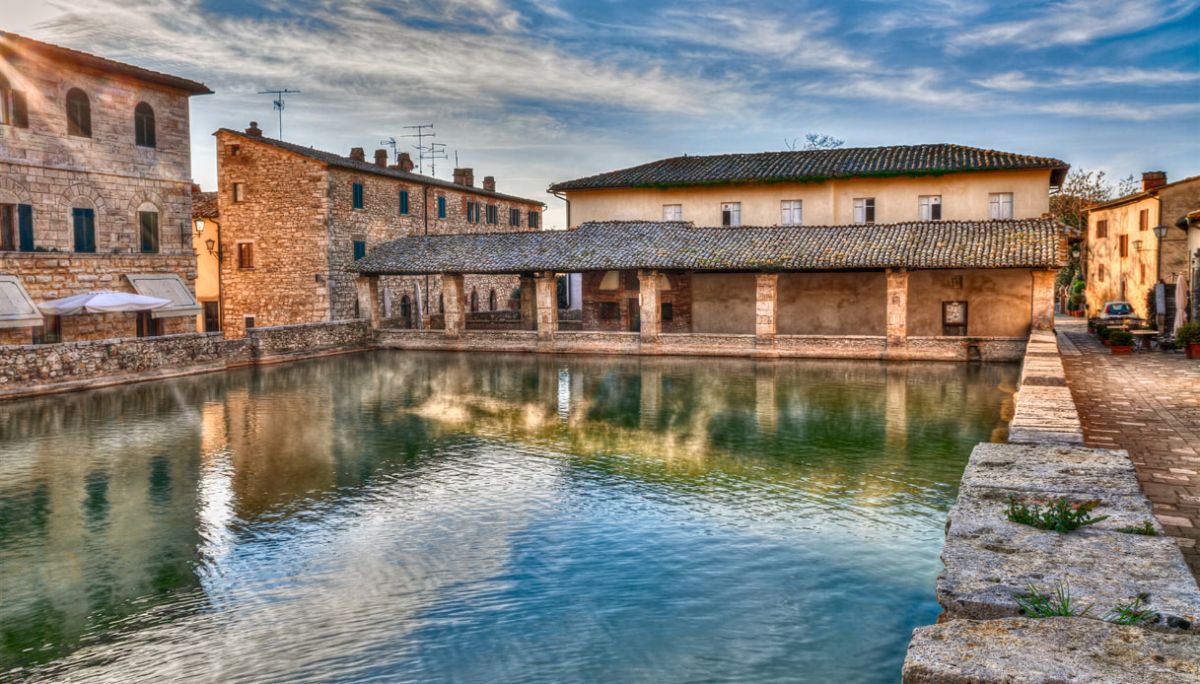
Assisi is the birthplace of Francis, the nobleman who renounced all his possessions to devote his life to helping the needy and became the most acclaimed Saint of the Catholic Church.
The splendid Basilica, one of the emblems of Christianity, located on Mount Subasio and overlooking the entire valley, is dedicated to him. Apart from being a strong appeal to millions of religious believers, the Basilica is a monument of great artistic value. The construction of the Basilica began two years after his death, in 1228, and between the end of the 13th and the beginning of the 14th century, the Basilica’s walls were frescoed by the best artists of that time: Giotto, Cimabue, Simone Martini and Pietro Lorenzetti. St. Francis’ Basilica consists of two churches laid upon each other and a crypt containing the tomb of the Saint. The Lower Basilica presents a simple facade with a double front portal embellished with a rose window and a mosaic. The interior is decorated with frescoes by some of the most important painters from 1200 to 1300, from Cimabue to Giotto, from the Lorenzettis to Simone Martini.
In the Upper Basilica, you will admire the frescoes of the life of St. Francis, painted by Giotto, the Old and New Testament stories covering the entire nave, and other beautiful frescoes by Cimabue and Torriti.
Another figure who profoundly influenced these places is Saint Clare, to whom the homonymous Basilica -with a facade made of white and pink stone and divided into three sections by horizontal cornices – is dedicated. The interior frescoes and the remains of the Saint are visible through a window in the crypt.
Try to enjoy the mystical atmosphere of Assisi:
“Be praised, my Lord, through our sister Mother Earth,
Who feeds us and rules us,
And produces various fruits with coloured flowers and herbs.”
(St. Francis, Prayer of the Canticle of the Creatures)
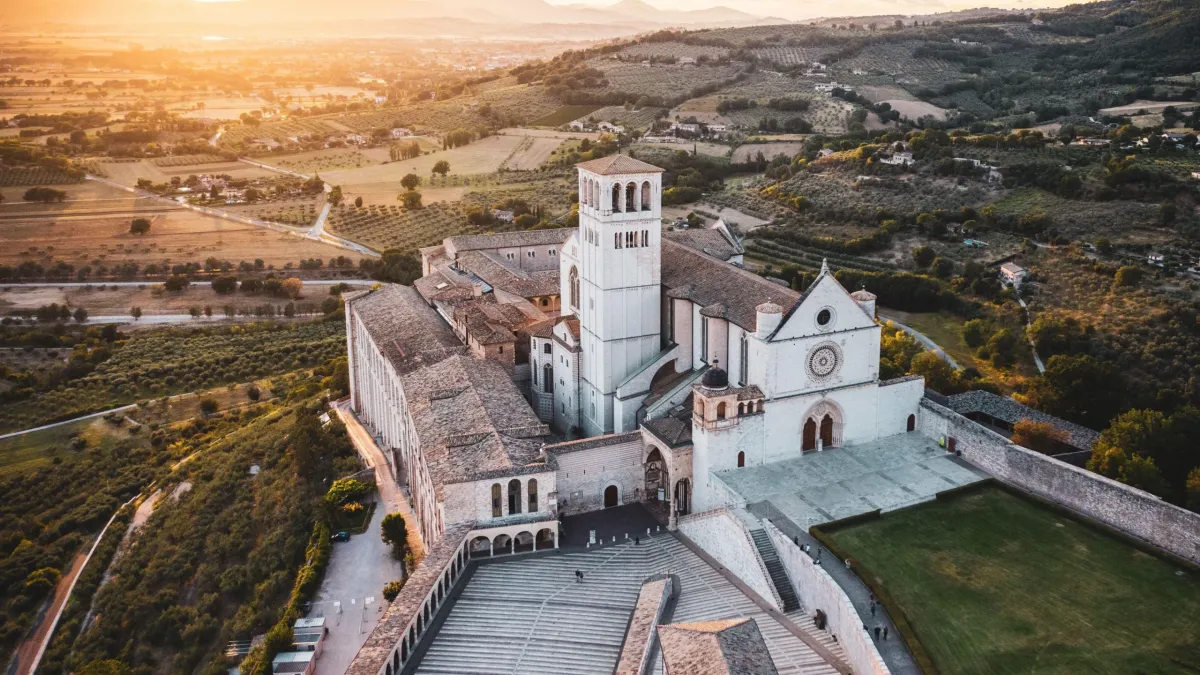
The area south of Rome is known as “Castelli Romani” (Roman Castles). The entire area originated from a series of volcanic eruptions that shook an original crater, creating some lakes. The area, a traditional destination for the out-of-town excursions of the Romans, is dotted with several pretty hill towns famous for their ancient history and highly regarded wine: Castelgandolfo, the summer residence of the pope, Rocca di Papa and Grottaferrata, known for their culture and gastronomic delicacies, Frascati, famous for its breathtaking views and its sweet and refreshing white wine named after the city, are only some of them.
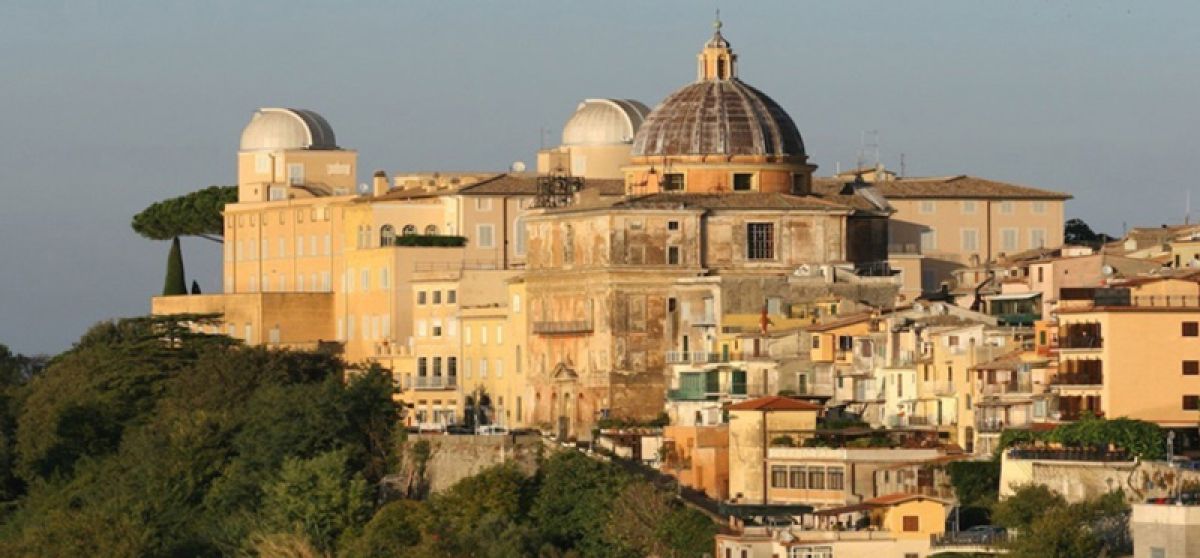
Costiera Amalfitana is Italy’s most scenic stretch of coastline, a landscape of pastel-coloured villages terraced into hillsides, steep panoramic roads, luxuriant gardens and enchanting vistas over turquoise waters and green mountains. Considered by UNESCO “an outstanding example of a Mediterranean landscape, with exceptional cultural and natural scenic values,” the coast has been a World Heritage Site since 1997. You may go from town to town at the discovery of Amalfi, Positano, and Ravello, three of the most beautiful villages in Southern Italy, world-famous for their charm and colourful architecture.
Amalfi typically has Mediterranean architecture with lanes and characteristic white houses piled one upon the other. In the Middle Ages, it was one of Italy’s four powerful maritime republics (with Venice, Pisa, and Genoa). All sea trade in the Mediterranean was once governed by the 12th century “Tavole Amalfitane”, one of the world’s oldest maritime codes. A must-see in Amalfi is the Duomo di Sant’Andrea, fronted by an intricately patterned façade, redone in the 19th century. Founded in the 9th century, the Cathedral’s subsequent alterations have spared its principal glory, the main portal’s 11th-century Byzantine bronze doors. Next to the church lies the Chiostro del Paradiso (1268), or Cloister of Paradise, whose serious Romanesque tone is animated by the Arab elements in its sinuous columns. To escape the bustle of Amalfi, let’s take the famous walk along the “Valle dei Mulini”, a steep-sided valley dotted with ruined watermills – “i mulini” – once used to make paper, an industry for which Amalfi was, and still is, famous.
Positano sits in a splendid panoramic position on one of the most beautiful stretches of coastline. Its enchanting town centre of delightful pastel-coloured houses surrounds the parish church of Santa Maria Assunta; its streets are lined with quaint, colourful shops, and its numerous beaches are world-famous.
Ravello is more elevated than the other pearls of the Amalfi Coast, boasting exceptional views of the coast and its marvellous villas and gardens. French novelist André Gide said they are “closer to the sky than the sea”. Here, you may visit Villa Rufolo, built in the 13th century, which hosted popes and kings, and Richard Wagner, who composed part of his opera Parsifal here in 1880. Views from its idyllic gardens are magnificent!
A trip to Cetara is an absolute must. The village is renowned for a particular gourmet speciality, “colatura di acciughe” (anchovy sauce), produced according to an ancient procedure for generations. Spaghetti with colatura di alici is the area’s typical recipe, a dish you will remember forever. Discover the secrets of the liquid gold of the Coast in the article in our BLOG.
At dinner, don’t miss Spaghetti with clams in olive oil and garlic sauce or Seafood Risotto with a glass of excellent Greco di Tufo white wine.
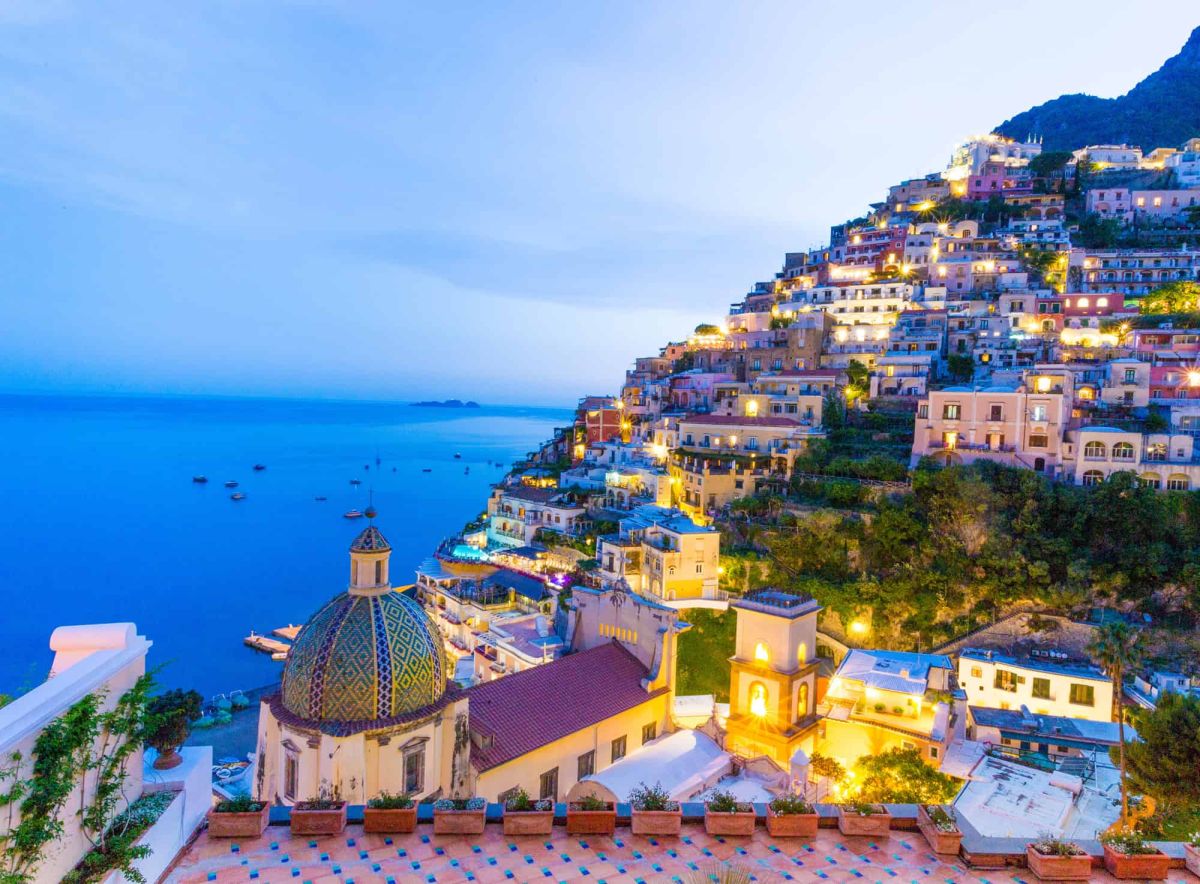
Located in the South-East of the Gulf of Salerno, Paestum is an archaeological site of extreme importance, recognised by UNESCO as part of the World Cultural Heritage. Built by the Greeks around the 7th century BC with the name of Poseidon, the city was later occupied by Romans, who made it a thriving colony, giving it its current name.
In addition to its cultural value, the importance of Paestum is linked to the excellent state of conservation of properties, starting from its walls, built by the Greeks and later strengthened by the Romans. Inside them, three majestic temples on a green plain reflect a different light depending on the hours and seasons. Many writers, poets and artists like Goethe, Shelley, Canova and Piranesi were fascinated by this sight, which later inspired them for their works.
These large buildings are a remarkable example of Doric-style architecture. The Temple of Hera, dating to the 6th century BC, is the most ancient building. The Temple of Neptune (5th century BC) is a massive construction made of travertine marble in a warm golden colour that varies at different times of the day. The Temple of Ceres (6th century BC), dedicated to the goddess Athena, was transformed into a church back in medieval times.
Besides its temples, Paestum is famous also for a gourmet speciality that you should taste on site: its “mozzarella di bufala”. Made with the best buffalo milk from the area, “mozzarella di bufala” is closely linked to the land of Campania; the skill it is made reflects the love the cheesemakers put into creating this Italian excellence. We will visit a cheese factory in the area to understand how it is created and taste it freshly made, an unforgettable experience!
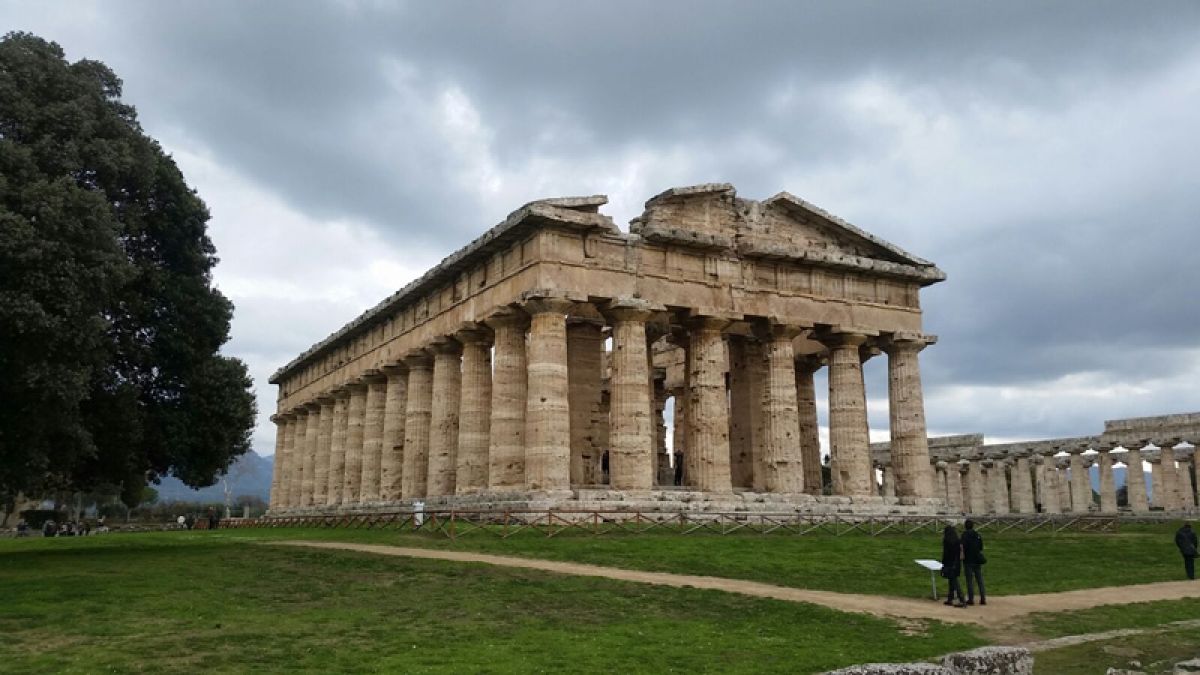
Matera is one of the oldest cities in the world, whose territory holds evidence of human settlements from the Paleolithic and has been without interruption until today. Touring Matera is like experiencing a forgotten past – you feel like setting foot in a nativity scene when you visit this charming city in Lucania. It’s no coincidence it’s referred to as “the second Bethlehem” and was the setting for Mel Gibson’s movie “The Passion” and the last James Bond, “No time to die”.
Matera is widely known as the city of the “Sassi”, the original urban nucleus, developed from the natural caves carved into the rock and subsequently modelled in increasingly complex structures.
In the 1950s, when the inhabitants who lived in the caves dug out of the mountain were forced to abandon those dwellings to settle in modern districts, no one would have ever thought that those grottos – the Sassi – would have become the symbol of a reborn city. UNESCO added the Sassi of Matera to its list of World Heritage Sites in 1993 as a whole and a millennial way of life to be preserved and handed down to our descendants. In fact, it was recognized as a model for living harmoniously with the environment while integrating with it and taking advantage of resources without disturbing the environment.
Geologists call it calcarenite, and ordinary folk refer to it as “tuff”: it’s the rock surrounding Matera that this land’s master artisans learned to work with in ancient times. This brittle, adaptable material is abundant in the mountain that dominates the city, so it seemed only natural for the people from Matera to go up there and dig out that rock to build a home. The extracted material was processed to make the façade of the dwelling. After the first home, others were constructed until the network of houses, tunnels, and alleyways became that magical place called Sassi – a gigantic sculpture, a miracle of town planning!
In Matera, you’ll discover one of the most beloved Italian breads. “Pane di Matera” is a bakery product for which only hard wheat semolina and sourdough are used. The characteristics to recognize the bread of Matera are the shapes, croissant or high bread, and a straw-yellow crumb. But besides bread, you’ll not miss other local specialities such as the Caciocavallo cheese or the “Lucanica” sausage.

Visiting Naples‘s historic centre means travelling through 20 centuries of history. The design of its streets, piazzas, churches, monuments, public buildings and castles constitute a jewel box of artistic and historical treasures of exceptional importance. Together, they earned their spot on the UNESCO World Heritage List in 1995. Naples is a real treasure of art and history, of indelible signs from past dominations, each of which has contributed to this city’s construction.
The city dominates the Gulf of Naples, expanding from the Sorrentine Peninsula to the volcanic area of the Phlegraean Fields. The most famous Neapolitan piazza is Piazza del Plebiscito, displaying the grand colonnade designed by Gioacchino Murat; in front of it is the magnificent Royal Palace designed by Domenico Fontana. Castel Nuovo’s different but well-integrated architectural lines, otherwise known as “Maschio Angioino”, evoke the double role of palace and fortress that this building played during the domination of the Anjou and Aragon families.
The churches in this city are countless. Over time, the Cathedral – erected upon pre-existing buildings, has undergone radical modifications to repair the damages caused by the earthquakes, especially on the outside. The interior hosts the famous “Cappella del Tesoro di San Gennaro” (“Chapel of St. Gennaro’s Treasure”), with the two vials containing the Saint’s blood.
And last but not least, you will not miss the Sansevero Chapel, commonly called “Pietatella” (Little Pietà). Here, you will be astonished by the “Cristo Velato” (Veiled Christ) by Giuseppe Sammartino, a masterpiece striking the eye with the extraordinary craftsmanship employed to sculpt the marble shroud over the body of Christ.
Naples is famous all over the world for its pizza. Yet, there is much more to this unique city’s culinary traditions. You will be pleasantly surprised by the variety and richness of flavours and recipes you’ll discover through our walking food tour. Your Guide will walk you into some of the best food venues in the city, known only to locals. Moving to the heart of the town, with its meandering streets and artisan shops, you will taste authentic mozzarella and try the best street food, such as pizza fritta or frittatina di maccheroni. Of course, we couldn’t do without a delicious bruschetta with Colatura di alici (a special dressing with origins dating back to Roman times).
The tour is over, but the memories of a fantastic journey will accompany you for a lifetime!
See more about your destinations on our YouTube channel.
Arrivederci for another tour with VITOR, Visit Italy on the Road.
